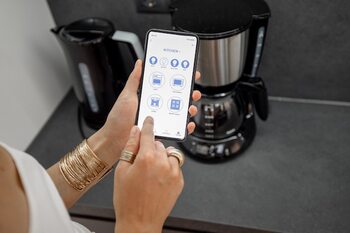Proactive security strategies with data analysis technology

Proactive security strategies with data analytics technology is a vital topic for the modern home. In a world where technology advances rapidly, integrating smart solutions into our homes not only enhances comfort but also strengthens our security. Discover how data analytics can transform your approach to home protection, anticipating threats and optimizing resources. Security is no longer a reaction; it is an intelligent proactivity that you can implement today!
What is proactive security and why is it essential?
Proactive security is an approach that seeks to anticipate and prevent possible threats before they materialize, rather than reacting to them once they have already occurred. This concept is based on the collection and analysis of relevant data to identify patterns and unusual behaviors that could indicate potential risks. In the context of the home, this means implementing smart systems that constantly monitor the environment, allowing homeowners to act in advance in any suspicious situation. Adopting this transformative mindset not only protects our material possessions but also the emotional peace of living in a safe space.
The importance of proactive security lies in its ability to significantly reduce vulnerabilities by providing an early response to threats. By integrating advanced technology such as connected surveillance cameras, motion sensors, and smart alarm systems, homes can enjoy a higher level of protection. Additionally, continuous data analysis allows for real-time strategy adjustments, improving the overall effectiveness of the system. With these tools at our disposal, each homeowner can become their own guardian, creating an environment where security is a constant priority and not just an occasional reaction to danger.
2. How data analysis is revolutionizing home security.
Data analysis is revolutionizing home security by enabling smarter and more adaptive surveillance. Thanks to the collection and processing of real-time information, security systems can identify patterns and anomalous behaviors that may indicate potential risks. For example, security cameras equipped with artificial intelligence not only record images but also analyze movement and recognize faces, allowing for the detection of suspicious activities before they become actual threats. This predictive capability transforms traditional security into a proactive system that responds to circumstances before incidents occur.
Furthermore, the integration of smart devices connected to a home network allows homeowners to receive instant alerts about any detected irregularities. Advanced systems use complex algorithms to evaluate historical and current data, constantly improving their effectiveness. By accumulating information on entry and exit times, as well as daily habits, these systems can automatically adjust their settings to maximize protection without interfering with the household routine. Thus, data analysis not only enhances incident response; it also optimizes the use of energy and financial resources by reducing false positives and ensuring continuous and efficient monitoring.
3. Technological tools to implement proactive strategies.
To implement proactive home security strategies, it is essential to have technological tools that allow for continuous monitoring and effective data analysis. Smart camera systems equipped with facial recognition and motion analysis can alert homeowners to suspicious activities in real time. These tools not only record what happens on the property but also analyze patterns and behaviors, enabling users to make informed decisions about when and how to act against potential threats. The integration of these technologies provides a level of security that goes beyond simple passive monitoring.
Another essential tool is connected sensors, which can detect everything from door openings to changes in temperature or air quality. By using advanced algorithms to process this information, these devices can predict dangerous situations before they occur. For example, if a sensor detects unusual activity during off-hours, it can send instant notifications to the user and automatically activate other security measures. This combination of technology allows not only to react to incidents but also to anticipate them, making the home a safer and more protected space.
4. Predictive analysis: Anticipating risks before they occur.
Predictive analysis has become an essential tool for anticipating risks at home, allowing homeowners to make informed decisions before an incident occurs. Through data collection and processing, it is possible to identify patterns and trends that may indicate potential threats. For example, advanced security systems can analyze unusual behaviors in the neighborhood or detect changes in traffic within the home, enabling early alerts and proactive resource mobilization. This ability to foresee potentially dangerous situations not only protects the home but also provides peace of mind to its inhabitants.
The implementation of predictive analytics goes beyond simple alarms; it involves integrating different technologies such as smart cameras, motion sensors, and connected devices. These elements work together to create an intelligent ecosystem capable of learning and adapting to the daily routines of the home. By using advanced algorithms, these systems can constantly assess the environment and notify homeowners of any anomalies. Thus, by adopting this proactive strategy, families are not only better prepared for potential risks but also optimize their response to emergencies, transforming the way they perceive safety in their day-to-day lives.
5. Integration of smart devices into the security strategy.
The integration of smart devices into the home security strategy is a crucial step towards more effective and proactive protection. These devices, ranging from cloud-connected surveillance cameras to smart locks and motion sensors, allow homeowners to monitor their home in real time. The collection and analysis of data from these devices not only facilitate the early detection of threats but also provide a comprehensive view of unusual patterns in home behavior. For example, if a sensor detects activity outside of normal hours, it can alert the homeowner instantly, enabling a quick response.
Furthermore, the ability to integrate these devices into a centralized system allows users to manage their security from a single mobile application or web platform. This not only simplifies control over all aspects of home security but also promotes a data-driven approach. The statistics collected by these systems can help identify vulnerable areas and adjust security strategies as needed. With advanced algorithms analyzing historical behavior, it is possible to anticipate specific risks and adapt preventive measures accordingly. Ultimately, the combination of smart technology and data analysis transforms home security into a dynamic and adaptable process.
6. The importance of constant monitoring and its impact on the tranquility of the home.
Constant monitoring at home has become a fundamental pillar within proactive security strategies. Thanks to data analysis technology, modern systems allow for continuous surveillance that not only detects threats in real-time but also analyzes patterns and unusual behaviors. This means that any suspicious activity can be quickly identified, enabling informed decisions and actions before a potentially dangerous situation escalates into a larger problem. With this monitoring capability, residents can enjoy a much stronger sense of security, reducing anxiety related to potential intrusions or incidents.
Moreover, the impact of constant monitoring goes beyond simple problem detection; it also influences the emotional peace of the home. With technological solutions that offer instant alerts and remote access to cameras and sensors, homeowners have the ability to monitor their space even when they are away. This connectivity not only provides greater peace of mind knowing that their home is protected, but also fosters an environment where residents can relax without worries. In short, integrating constant monitoring as an integral part of security strategies not only protects material goods but also strengthens emotional well-being and quality of life within the home.
7. Case studies: Successes in proactive security with data analysis.
One of the most notable cases in the implementation of proactive security through data analysis can be observed in communities that have adopted smart surveillance systems. For example, some neighborhoods have used analysis platforms to compile data on suspicious activities reported by residents. By processing this information, patterns have been identified that alert local authorities and neighbors about potential risks before they become real incidents. This approach not only improves the response to possible threats but also fosters a sense of community by involving everyone in collective vigilance.
Another successful case is the use of connected sensors and IoT (Internet of Things) devices in individual homes, which collect data on the daily behavior of their inhabitants. By analyzing this data, it is possible to detect anomalies that could indicate problems such as an intrusion or a medical emergency. For example, a system can learn the usual schedules and notify the owner if it detects unusual activity during the night. Additionally, many systems now allow integration with mobile applications to provide real-time updates and recommendations on how to further improve home security. This anticipatory capability radically transforms the way we protect our most cherished spaces.
8. Tips for choosing the best technological tools for your home.
When choosing technological tools to enhance the security of your home, it is essential to consider several aspects that ensure effective and sustainable integration. First, analyze the specific needs of your home: are you looking for surveillance cameras, alarm systems, or smart devices that control access? Evaluating which areas you want to protect will allow you to select the most suitable devices. Additionally, it is crucial that these tools are compatible with each other and with other smart devices you already have at home, thus ensuring an integrated and efficient ecosystem.
Another key aspect is the ease of use and accessibility of the selected tools. Choose solutions that offer intuitive interfaces and user-friendly mobile applications so you can monitor and control your security system from anywhere. Also, consider technical support and frequent software updates; this will ensure that your devices are always protected against vulnerabilities. Ultimately, investing in home technology should be an informed decision that prioritizes both protection and comfort, contributing to a safe and peaceful environment for you and your family.
9. Myths about technology and its effectiveness in home security.
Often, myths about technology and its effectiveness in home security can create a false sense of security or, conversely, generate distrust in the available solutions. One of the most common myths is that security cameras are sufficient to prevent thefts. However, while these tools are valuable for surveillance, they do not guarantee the prevention of a crime in progress. The true effectiveness lies in combining multiple data analysis technologies, such as smart alarms and motion sensors, that work together to provide a comprehensive response to any threat.
Another widespread myth is that artificial intelligence (AI) is only accessible to large companies or institutions. In reality, there are affordable and user-friendly solutions today that give homeowners the ability to integrate AI into their security systems. These technologies can learn from everyday behavior and alert about unusual activities before they become serious problems. By demystifying these misconceptions about technology, homeowners can adopt a more proactive mindset towards home protection, making the most of the available tools to strengthen their personal and family security.
10. Future of home security: Emerging trends and technologies to come.
The future of home security is marked by an increasingly innovative approach, where emerging technologies such as artificial intelligence and the Internet of Things (IoT) are transforming the way we protect our spaces. The integration of smart devices allows not only to monitor and control the environment but also to analyze behavior patterns and detect anomalies in real time. This means that security systems can learn and adapt to the daily routines of the inhabitants, anticipating potential threats before they occur. Thus, personalization becomes a key tool to maximize the effectiveness of preventive measures.
Additionally, emerging trends point towards greater interconnectivity among home devices, facilitating a more secure and efficient ecosystem. For example, advanced surveillance cameras equipped with facial recognition can identify known individuals and alert about potential intruders. Similarly, the use of drones for patrolling or monitoring can complement traditional systems, providing additional coverage that is hard to match. In this way, the combination of data analysis with smart technologies not only optimizes incident response but also creates an environment where each element works together to protect what is most valuable: our home and our loved ones.



